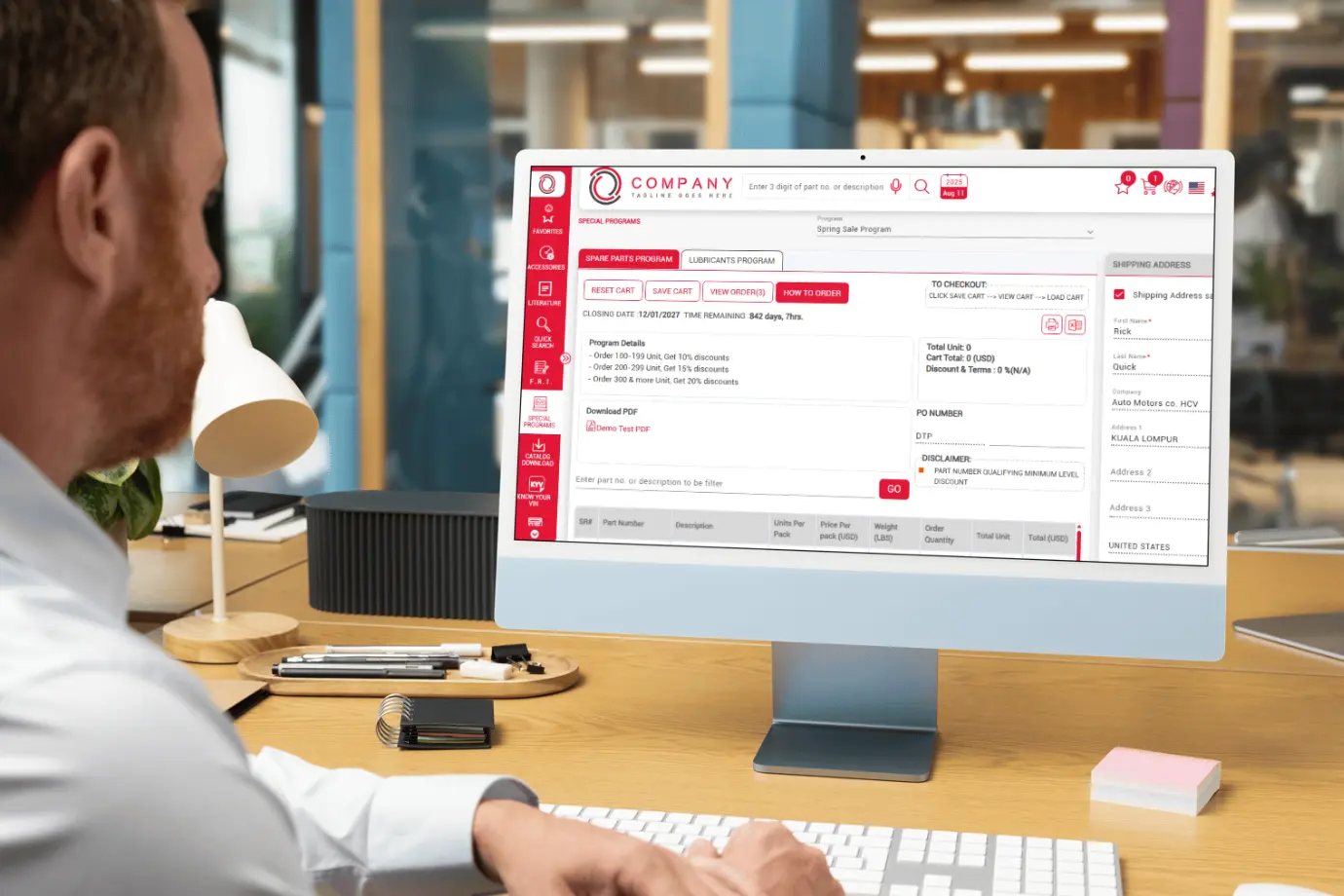
Across many industries, from heavy industrial equipment to automotive, original equipment manufacturers (OEMs) are under increasing pressure to improve aftermarket performance. According to a report published by McKinsey & Company, aftermarket services can contribute significantly more to OEM margins than initial equipment sales. One of the most effective strategies for supporting aftermarket growth and strengthening dealer relationships is a well-executed discounting approach.
If applied with strategy, discounts do not merely boost sales for a brief period of time; they can bind the dealer relationship, improve inventory turnover, and enhance customer loyalty. With the growing dealer networks and expanding complexity of product portfolios, these classical methods of discount management through spreadsheets, emails, or isolated pricing tools simply begin to break down.
This complexity calls for more than pure manual effort. It demands structure, speed, and visibility. Hence, many OEMs have been adopting a discount management system, a platform that consolidates the issuance, administration, and tracking of promotional programs across markets. When integrated with a high-integrity spare parts catalog software, it can serve as a single point in the execution of discounting strategies at almost unfathomable levels of precision and scale.
This blog outlines the limitations of traditional discounting methods, the benefits offered by a system approach, and business impacts arising when discount workflows are integrated with catalog operations. Moreover, this blog talks about key features, use cases, and the future of discount optimization within a data-driven aftermarket ecosystem.
Why Traditional Discounting Methods Fall Short?

For years, many OEMs have relied on manual processes to manage dealer promotions, e.g., bulk email communications, static spreadsheets, and last-minute calls to communicate offers. While they might have worked when scaled minimally, the aftermarket demands cannot keep pace with these systems.
Thus, traditional discounting methods have the following setbacks:
- No real-time view: Dealers generally do not receive discount information until it is too late or simply miss it entirely.
- Manual rollout delays execution: Execution of new promotions can take days, sometimes even weeks, depending on approvals and coordination across regions.
- No single-point control: With no formal discounting system, such decisions remain fragmented across teams, leading to errors, inconsistencies, and miscommunication.
- Hard to scale geographically: Without automation, localized offers for different markets become a logistical headache.
- Little or no tracking and performance assessment: Spreadsheets don't speak their analytics about working programs and adjustments that need to be made.
- Bundled and bulk deals become messy: Trying to manually manage complex offers, like multi-product bundles or volume-based tiers, results in confusion and missed opportunities.
The Need for a Discount Management System Integrated with Parts Catalog System

Any discount, regardless of attractiveness, works only if seen, understood, and easily acted upon. For OEMs with large dealer networks and relatively large product lines, the link between discount management and product visibility becomes crucial.
A modern discount management system integrated adequately with the parts catalog system ensures that dealers do not have to look elsewhere or toggle between systems to access live offers. Instead, discounts appear outright in their ordering platform when they need to use them, without any ambiguity, with context.
Why Integration Matters
- Pricing, inventory, and promotion aligned: A discount may fail if its eligibility does not match an existing inventory level, or if prices are inconsistent across tools. Integration sustains synchronization.
- Single source of truth: Dealers access parts and their discounts in the same system. This limits confusion and errors.
- Real-time updates: Promotions are launched or changed instantaneously, while in turn, changes are immediately reflected in the catalog.
- Efficiency: It goes live without having to swim through rounds of back-and-forth emails or uploading CSV files within the catalog.
- Audit trails and compliance: With automated tracking, OEMs can ensure that their members are using it properly, thus avoiding misuse or revenue leakage.
Pairing a discount management system with your parts catalog system doesn’t just modernize the discounting process; it makes it actionable, measurable, and scalable.
Core Capabilities of Intelli Catalog’s Discount Management Module

For OEMs trying to grapple with increasingly complex sets of promotions across dealers, Intelli Catalog has a discount management system designed for the future, yet one that favors real-world dealer workflows. From 24/7 virtual storefronts to intellect-tiered pricing, the system is an OEM toolkit enabling the creation of almost any discounting program, which is an add-on module available within Intelli Catalog.
Let’s break down the key capabilities that set it apart:
1. Virtual Parts and Accessories Fairs
A permanent, never-ceasing digital space where OEMs showcase time-sensitive offers and featured SKUs for the online trade fair energy infusion.
Benefits:
- 24/7 dealer access to promotions to buy anywhere.
- Encourages spontaneous buying and cross-selling by itself.
- Supports banners, themes, and rich media to boost visibility and urgency.
2. Configurable Special Programs
Design customized discount programs with very specific controls, whether for bundling particular parts with conditional discounts or to encourage bulk buying.
Key features:
- Bundle configuration by part number, quantity, and price.
- Time-based offers that auto-activate and expire.
- Custom payment terms and dealer eligibility rules.
3. Dynamic Discount Slabs
Instead of offering a flat-rate discount, intelligent slabs according to quantity, value, or category could be designed to induce larger orders and reward better dealer performance.
Highlights:
- Real-time visibility for dealers of which slab they are eligible for and how much benefit they stand to gain from it.
- Slabs can be defined on the basis of item groups, geographies, or dealer segments.
- The system instantly applies the correct price at checkout.
4. Streamlined Dealer Experience
No separate portal required. The entire discount management system is integrated within the catalog that the dealers already use, thereby reducing friction and boosting adoption.
Dealer advantages:
- Instant preview of discounts while selecting parts in the catalog.
- Cart suggestions are optimized based on active offers.
- Consistent experience on web and mobile interfaces.
Together, these capabilities create a robust, flexible framework for OEMs to plan and scale discount strategies without the usual manual overhead.
How It Works: A Step-by-Step Discount Journey for Dealers

A promotional program is only as good as the experience it offers to its dealers. Intelli Catalog’s discount management system makes discount selection and redemption intuitive, speedier, and fully transparent.
A usual discount journey through the system for a dealer unfolds as follows:
Step-by-Step Workflow:
- Log in to Intelli Catalog: Dealers log in using their existing Intelli Catalog, with no requirement to access a separate portal or dashboard.
- Access Discount Programs: Active discount programs appear in the main interface or as tags beside the eligible parts. The catalog has a dedicated section that offers complete visibility for all ongoing campaigns.
- Discover Discount Opportunities. Dealers can:
- Browse limited-time offers or seasonal programs.
- View quantity-based price slabs.
- Explore bundled promotions, accompanied by price breakdowns.
- Real-Time Preview and Cart Optimization: As dealers are ordering parts, the system recommends adjustments in quantity or alternate parts for bigger discounts. They preview changes instantly whenever selections are made.
- Discount Checkout. If discounts are applied, orders are processed within the same checkout route, thereby allowing:
- Use of special payment terms (if appropriate).
- Auto-calculation on applicable discounts.
- Clear tracking and easy reconciliation after the sale.
- Confirmation and Order Tracking: Dealers are issued with discount-applied confirmation order details, estimated delivery, and applicable return terms within the relevant dealer portals.
Backend Process:
While the front-end experience is seamless, the system works behind the scenes to ensure compliance, accuracy, and automation:
- Automated eligibility checks based on dealer region, tier, or order volume.
- Synchronizes inventory levels in real-time to avoid overselling.
- Activates and expires campaigns automatically based on business rules.
This results in a frictionless experience for dealers with OEMs sustained with scalable and error-free processes. With that, there are no opportunities missed, no manual corrections, or no ill-timed rollouts.
Business Benefits of an Integrated Discount Management System

For OEMs, going from the traditional type of discounting to an integrated discount management system presents an opportunity much sought after as a competitive advantage. When an advertisement program is passed off into the Intelli Catalog, the easier it is to realize, observe, measure, and ultimately drive business results.
Here are the key benefits:
1. Increased Parts Sales and Dealer Engagement:
- Higher volumes of orders come in through dynamic pricing slabs and bundled incentives.
- Good dealer retention through timely personalized incentives.
- Improved visibility into the underperformance of certain SKUs and targeted promotions.
2. Reduced Operational Overhead:
- Means no need to undertake back-and-forth email chains, spreadsheet uploads, or offline coordination.
- Completion of everything from the discount application to expiry management.
- Program teams can launch more campaigns in less time with fewer errors.
3. Accelerated Movement of Slow-Moving or Seasonal Inventory:
- Push promotions for aged SKUs within the catalog environment.
- Provide incentives for dealers to buy less popular parts with zero or very minimal, necessitated effort required by the dealers.
- Use promotions for matching supply and demand in an agile manner.
4. Granular Insights and Control:
- Track dealer participation, conversion rates, and ROI of campaigns.
- Observe program performance across parameters like region, product category, or time periods.
- Based on the obtained results, change slabs, bundles, or eligibility rules in real time.
5. Improved Accuracy and Compliance:
- Automatic compliance with business rules to minimize discounting errors or misuse.
- Automatically audit and log dealer interactions in real-time.
- Streamline conversations with finance and pricing through clean data trails.
An inherent purpose-built discount management system provides the structure and scale OEMs need to make discounting a reliable lever, instead of a guessing game.
Real-World Impact: Use Case Scenarios
Aside from great feature lists, a discount management system is best proven in application. Across industries, OEMs from industrial machinery to consumer electronics are implementing these systems to run more intelligent campaigns for addressing aftermarket problems thrust on them for years.
Here is a working example of the measurable impact of having discounting go fully unified:
Launching a Country-Wide Seasonal Discount
The challenge: A regional sales team wants to promote selected SKUs to clear inventory and meet revenue targets before the financial year ends.
With a discount management system:
- The sales unit schedules a 10-day seasonal discount on selected lines.
- Eligible dealers receive real-time alerts and catalog notifications.
- Orders spike toward the last hours of the campaign because of visibility and urgency.
- Post-campaign analytics show which regions and tiers of dealers performed best.
Result: Sales volume increased by 22%, while stock was cleared 35% faster, and there was no increase in support costs.
This example underscores how an integrated approach to discount management can turn pricing into a strategic growth driver, tailored to different goals, seasons, and business cycles.
Future Outlook: Discounting in a Data-Driven Parts Ecosystem

As the aftermarket becomes more connected and digital, discount management no longer stops at static pricing and fixed campaigns. OEMs are thus increasingly embracing data, automation, and predictive models to pursue smarter and highly responsive discount strategies-varying on real-time and based on their own broader business objectives. Here are emerging technologies that are transforming discount management from a reactive sales tool into a proactive, data-driven strategy for OEMs:
- AI-Based Discount Optimization: Uses machine learning to analyse sales history, inventory trends, and dealer behavior to recommend optimal discount rates, timing, and campaign duration while assessing operational risks.
- Predictive Promotions Based on Dealer Activity: Leverages purchase patterns, engagement data, and location insights to run targeted campaigns, reactivate dormant dealers, and push slow-moving stock in anticipated high-demand areas.
- Cross-Platform Discount Visibility: Ensures consistent pricing and promotion information across mobile apps, web portals, and procurement platforms, with APIs for third-party integration and digital triggers like push notifications.
- Sustainability and Responsible Inventory Management: Incorporates factors like carbon emissions impact, local stock availability, and efficient returns to align discounting with waste reduction and logistics optimization.
Discount management in the future is going to become highly digital, intelligent, and predictive, with sustainability at heart. OEMs that can begin investing today will develop market precedence, alongside stronger partnerships with dealers that run on data.
Discounting as a Growth Lever for OEM Aftermarket
When performed correctly, discounting is so much more than a simple promotional tactic; it is truly a growth engine. OEMs in fast-paced environments of aftermarket operations will see an impact on parts sales, dealer engagement, and operational efficiency if they have a tangible discount plan for real-time implementation.
But the real change passes when discounting is not pushed aside as secondary but is considered primary and deeply ingrained within the OEM's existing ecosystem. Through a modern discount management system interfacing expediently with Intelli Catalog, the OEM gains visibility and control and attains agility to execute smarter, data-driven campaigns at scale.
From seasonal promotions to moving end-of-life inventory and everything in between, this solution forms the foundation for sustained aftermarket success.
Maximize your aftermarket growth with a discount management approach that’s smart, strategic, and effortless. Book a free demo to see how Intelli Catalog empowers OEMs to manage discounts with precision and impact.
Explore More Insights
About the Author
Chandra Shekhar
Chandra Shekhar is the Senior Manager, Strategy & Business Development at Intellinet Systems. With over a decade of experience in the automotive industry, Chandra Shekhar has led digital transformation and aftersales strategy initiatives for OEMs across multiple markets. His background combines deep industry knowledge with a practical understanding of how technology can solve real operational challenges. He focuses on making complex ideas clear and relevant for automotive and aftermarket professionals navigating ongoing change.


























